C语言函数大全
本篇介绍C语言函数大全--e开头的函数
1. ecvt
1.1 函数说明
char ecvt(double value, int ndigit, int *decpt, int *sign);
把一个双精度浮点型数转换为字符串,转换结果中不包括十进制小数点
value : 待转换的双精度浮点数。 ndigit :存储的有效数字位数。这个函数存储最多 ndigit 个数字值作为一个字符串,并添加一个结束符('\0'),如果 value 中的数字个数超过 ndigit,低位数字被舍入。如果少于 ndigit 个数字,该字符串用 0填充。 decpt :指出给出小数点位置的整数值, 它是从该字符串的开头位置计算的。0 或负数指出小数点在第一个数字的左边。 sign :指出一个指出转换的数的符号的整数。如果该整数为 0,这个数为正数,否则为负数。
1.2 演示示例
#include <stdlib.h>
#include <stdio.h>
#include <conio.h>
int main()
{
char *string;
double value;
int decpt, sign;
int ndigit = 10;
value = 9.876;
string = ecvt(value, ndigit, &decpt, &sign);
printf("string = %-16s decpt = %d sign = %d value = %lf\n", string, decpt, sign, value);
value = -123.45;
ndigit= 15;
string = ecvt(value, ndigit, &decpt, &sign);
printf("string = %-16s decpt = %d sign = %d value = %lf\n", string, decpt, sign, value);
value = 0.6789e5; /* 科学记数法 scientific notation */
ndigit = 5;
string = ecvt(value, ndigit, &decpt, &sign);
printf("string = %-16s decpt = %d sign = %d value = %lf\n", string, decpt, sign, value);
return 0;
}
1.3 运行结果
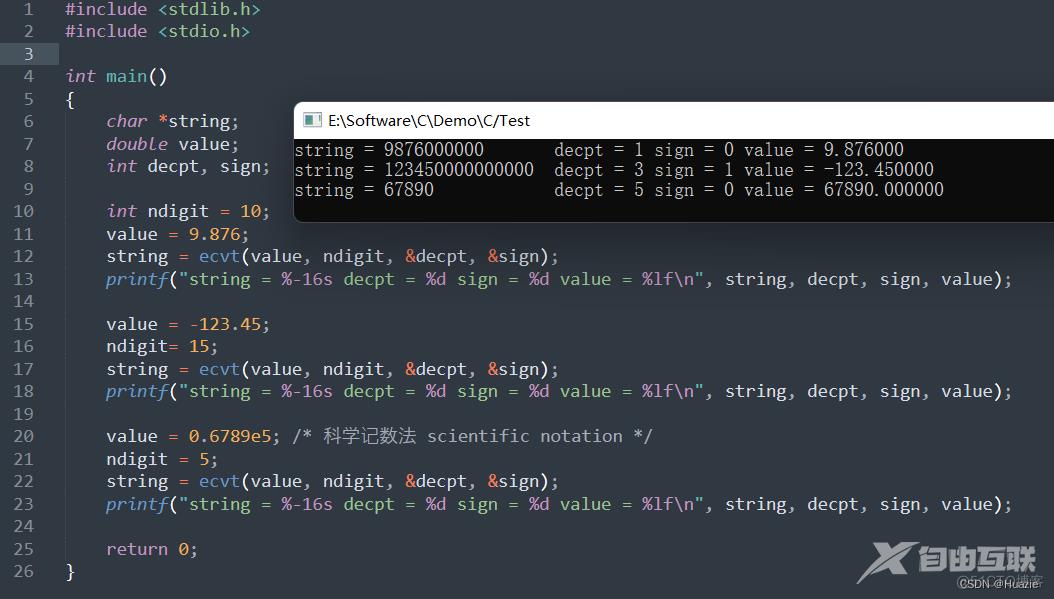
2. ellipse
2.1 函数说明
void ellipse(int x, int y, int stangle, int endangle, int xradius, int yradius);
画一段椭圆线
以 (x, y) 为中心,xradius、yradius 为 x 轴 和 y 轴 半径,从角 stangle 开始,endangle 结束,画一段椭圆线。当stangle=0,endangle=360 时,画出一个完整的椭圆
2.2 演示示例
#include <graphics.h>
#include <stdlib.h>
#include <stdio.h>
int main(void)
{
// request auto detection
int gdriver = DETECT, gmode, errorcode;
int midx, midy;
int stangle = 0, endangle = 360, midangle = 180;
int xradius = 100, yradius = 50;
// initialize graphics, local variables
initgraph(&gdriver, &gmode, "");
// read result of initialization
errorcode = graphresult();
if (errorcode != grOk) // an error occurred
{
printf("Graphics error: %s\n", grapherrormsg(errorcode));
printf("Press any key to halt:");
getch();
exit(1);
}
midx = getmaxx() / 2;
midy = getmaxy() / 2;
setcolor(getmaxcolor());
// draw ellipse
ellipse(midx, 50, midangle, endangle, xradius, yradius);
ellipse(midx, midy, stangle, endangle, xradius, yradius);
ellipse(midx, getmaxy() - 50, stangle, midangle, xradius, yradius);
getch();
closegraph();
return 0;
}
2.3 运行结果
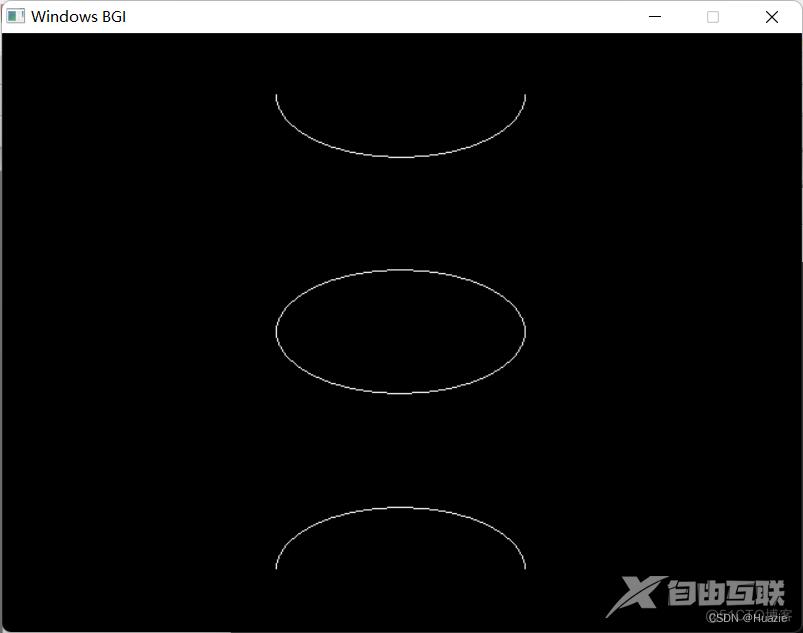
3. eof
3.1 函数说明
int eof(int *handle);
检测文件结束
3.2 演示示例
#include <sys\stat.h>
#include <string.h>
#include <stdio.h>
#include <fcntl.h>
#include <io.h>
int main(void)
{
int handle;
char msg[] = "This is a test";
char ch;
// create a file
handle = open("STU.FIL", O_CREAT | O_RDWR, S_IREAD | S_IWRITE);
// write some data to the file
write(handle, msg, strlen(msg));
// seek to the beginning of the file
lseek(handle, 0L, SEEK_SET);
// reads chars from the file until hit EOF
do
{
read(handle, &ch, 1);
printf("%c", ch);
} while (!eof(handle));
close(handle);
return 0;
}
3.3 运行结果
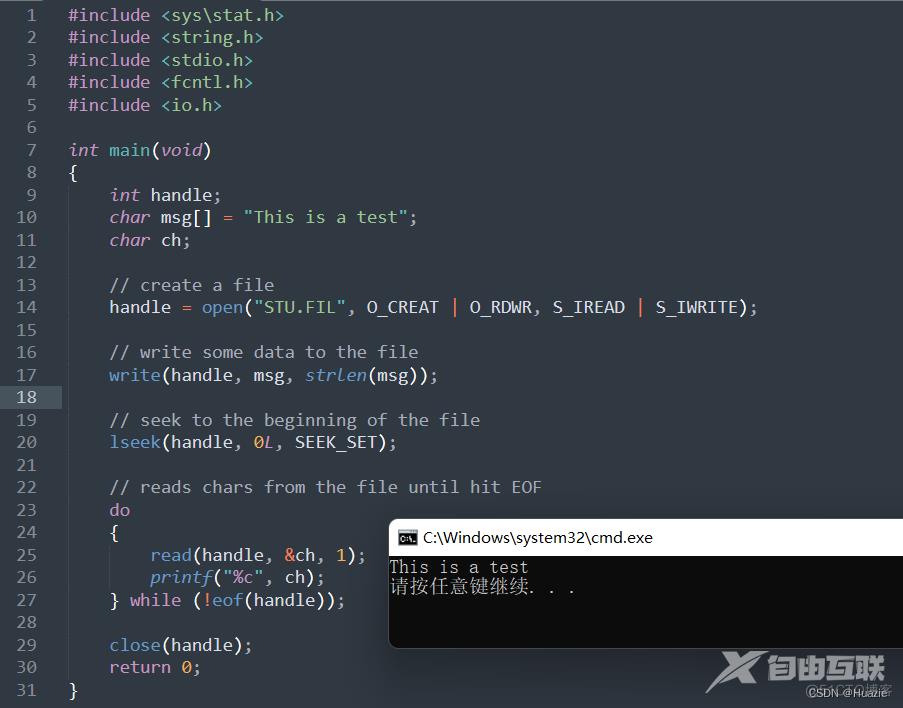
4. execl
4.1 函数说明
int execl(const char *pathname, const char *arg0, ... const char *argn, NULL);
载入并运行其它程序
注意: execl 函数,其后缀
l代表 list,也就是参数列表的意思。第一个参数 path 字符指针指向要执行的文件路径, 接下来的参数代表执行该文件时传递的参数列表:argv[0],argv[1]...,最后一个参数须用空指针 NULL 作结束。
4.2 演示示例
4.2.1 SubTest.c
#include <stdio.h>
int main(int argc, char *argv[])
{
printf("exec %s, Hello, %s", argv[0], argv[1]);
return 0;
}
4.2.2 Test.c
#include <process.h>
#include <stdio.h>
#include <errno.h>
void main(int argc, char *argv[])
{
int i;
printf("Command line arguments:\n");
for (i=0; i<argc; i++)
printf("[%d] : %s\n", i, argv[i]);
printf("exec SubTest with subargv ...\n");
// 成功则不返回值, 失败返回-1, 失败原因存于errno中,可通过perror()打印
// 第一个参数需要执行文件的全路径,这里写直接文件名,是因为和当前源码在同一目录中
int result = execl("SubTest.exe", argv[0], "Huazie" , NULL);
// 执行成功,这里不会执行到
printf("result = %d\n", result);
perror("exec error");
exit(1);
}
4.3 运行结果
执行失败:
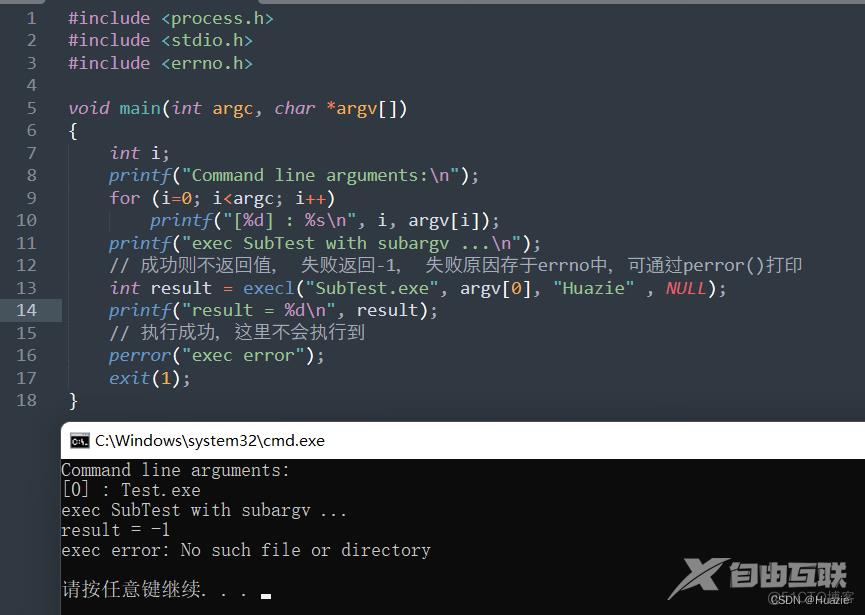 执行成功:
执行成功:
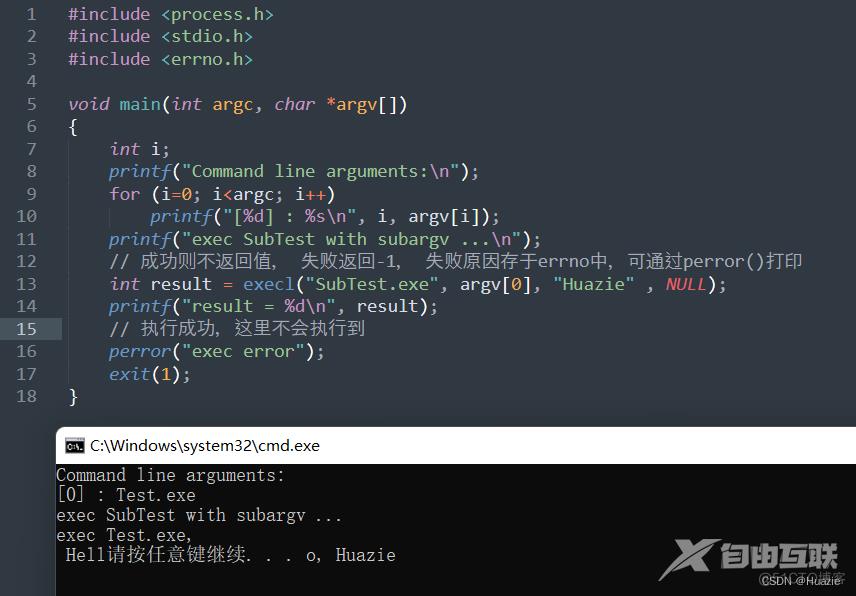
5. execle
5.1 函数说明
int execle(const char *pathname, const char *arg0, ... const char *argn, NULL, const char *const *envp);
载入并运行其它程序
注意: execl 函数是用来执行参数 path 字符串所代表的文件路径。接下来的参数代表执行该文件时传递过去的
argv[0], argv[1]…,并且倒数第二个参数必须用空指针 NULL 作结束,最后一个参数为 环境变量。
5.2 演示示例
5.2.1 SubEnvTest.c
#include <process.h>
#include <processenv.h>
#include <stdio.h>
int main(int argc, char *argv[], char **envp)
{
printf("SubEnvTest Command line arguments:\n");
for (int i=0; i<argc; i++)
printf("[%d] : %s\n", i, argv[i]);
printf("exec %s, Hello, %s\n", argv[0], argv[1]);
for (int i = 0; envp[i] != NULL; i++)
{
printf("%s\n", envp[i]);
}
// while(*envp != NULL)
// printf(" %s\n", *(envp++));
return 0;
}
5.2.2 Test.c
#include <process.h>
#include <stdio.h>
#include <errno.h>
void main(int argc, char *argv[])
{
int i;
printf("Command line arguments:\n");
for (i=0; i<argc; i++)
printf("[%d] : %s\n", i, argv[i]);
printf("exec SubEnvTest with subargv ...\n");
const char *envp[] = {"AUTHOR=Huazie", "DATE=2023-03-28", NULL}; // 环境变量
// 成功则不返回值, 失败返回-1, 失败原因存于errno中,可通过perror()打印
// 第一个参数需要执行文件的全路径,这里直接写文件名,是因为和当前源码在同一目录中
int result = execle("SubEnvTest.exe", argv[0], "Huazie" , NULL, envp);
// 执行成功,这里不会执行到
printf("result = %d\n", result);
perror("exec error");
exit(1);
}
5.3 运行结果
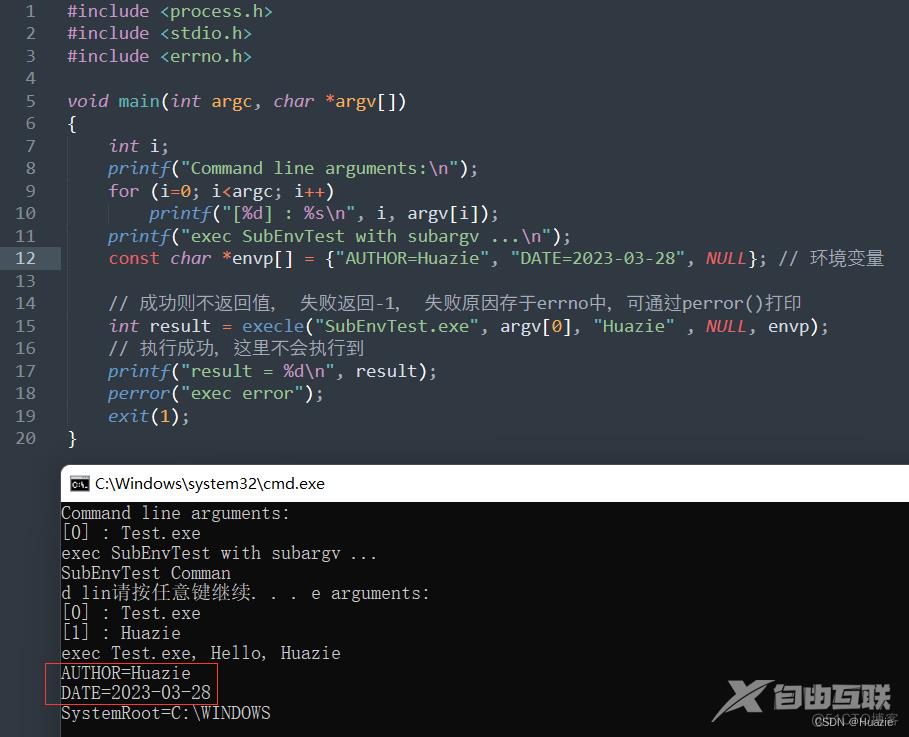
6. execlp
6.1 函数说明
int execlp(char *pathname, char *arg0, ... const char *argn, NULL);
载入并运行其它程序
注意: execlp 函数会从 PATH 环境变量所指的目录中查找符合参数 pathname 的文件名,找到后便执行该文件,然后将第二个以后的参数当做该文件的
arg0, arg1, …,最后一个参数必须用 空指针 NULL 作结束。
6.2 演示示例
#include <process.h>
#include <stdio.h>
#include <errno.h>
void main(int argc, char *argv[])
{
int i;
printf("Command line arguments:\n");
for (i=0; i<argc; i++)
printf("[%d] : %s\n", i, argv[i]);
printf("exec java with subargv ...\n");
// 成功则不返回值, 失败返回-1, 失败原因存于errno中,可通过perror()打印
int result = execlp("java.exe", "java", "-version", NULL);
// 执行成功,这里不会执行到
printf("result = %d\n", result);
perror("exec error");
exit(1);
}
6.3 运行结果
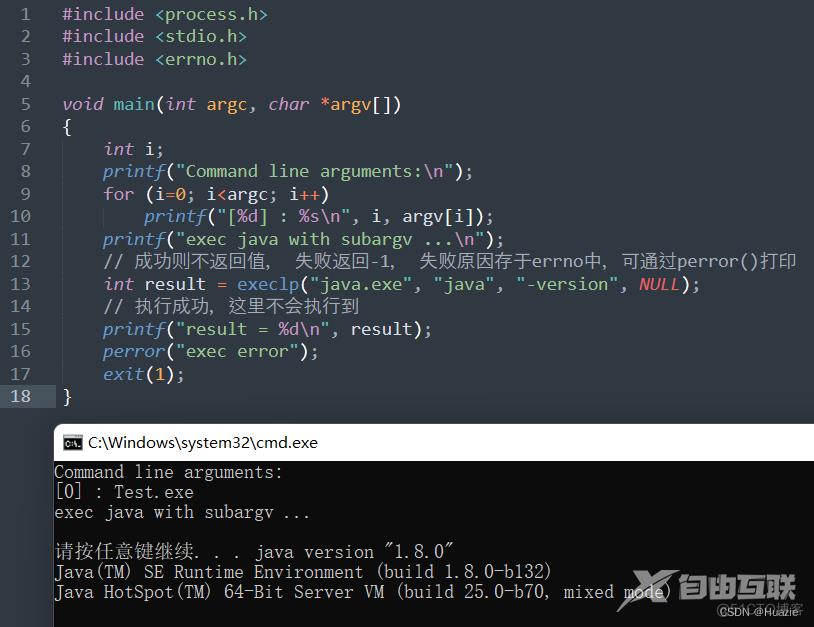
7. execlpe
7.1 函数说明
int execlpe(const char *pathname, const char *arg0, ... const char *argn, NULL, const char *const *envp);
载入并运行其它程序
注意: execlp 函数会从 PATH 环境变量所指的目录中查找符合参数 pathname 的文件名,找到后便执行该文件,然后将第二个以后的参数当做该文件的
arg0, arg1, …,其中倒数第二个参数必须用 空指针 NULL 作结束,最后一个参数为 环境变量。
7.2 演示示例
7.2.1 SubEnvTest.c
参考 5.2.1 的 SubEnvTest.c
7.2.2 Test.c
#include <process.h>
#include <stdio.h>
#include <errno.h>
void main(int argc, char *argv[])
{
int i;
printf("Command line arguments:\n");
for (i=0; i<argc; i++)
printf("[%d] : %s\n", i, argv[i]);
printf("exec SubEnvTest with subargv ...\n");
const char *envp[] = {"AUTHOR=Huazie", "DATE=2023-03-28", NULL}; // 环境变量
// 成功则不返回值, 失败返回-1, 失败原因存于errno中,可通过perror()打印
int result = execlpe("SubEnvTest", argv[0], "Huazie", NULL, envp);
// 执行成功,这里不会执行到
printf("result = %d\n", result);
perror("exec error");
exit(1);
}
7.3 运行结果
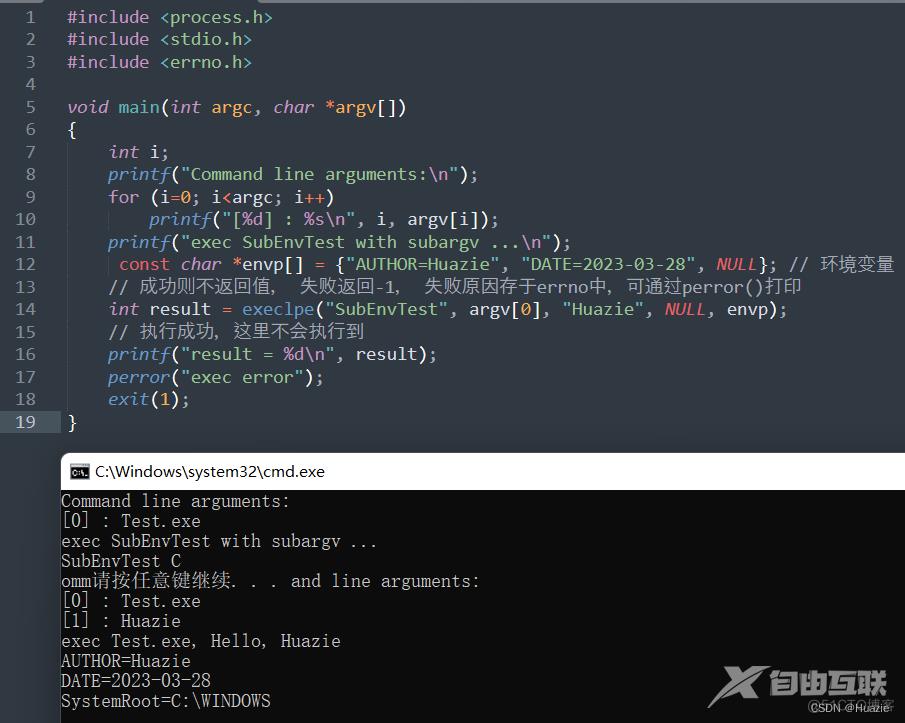
8. execv
8.1 函数说明
int execv(const char *pathname, char *const *argv);
载入并运行其它程序
注意:execv 函数用来运行參数 pathname 字符串所指向的程序,第二个参数 argv 为參数列表【该数组的最后一个元素必须是空指针 NULL】。
8.2 演示示例
8.2.1 SubTest.c
参考 4.2.1 的 SubTest.c
8.2.2 Test.c
#include <process.h>
#include <stdio.h>
#include <errno.h>
void main(int argc, char *argv[])
{
int i;
printf("Command line arguments:\n");
for (i=0; i<argc; i++)
printf("[%d] : %s\n", i, argv[i]);
printf("exec SubTest with subargv ...\n");
char *const subargv[] = {argv[0], "Huazie" , NULL}; // 参数列表
// 成功则不返回值, 失败返回-1, 失败原因存于errno中,可通过perror()打印
// 第一个参数需要执行文件的全路径,这里写直接文件名,是因为和当前源码在同一目录中
int result = execv("SubTest.exe", subargv);
// 执行成功,这里不会执行到
printf("result = %d\n", result);
perror("exec error");
exit(1);
}
8.3 运行结果
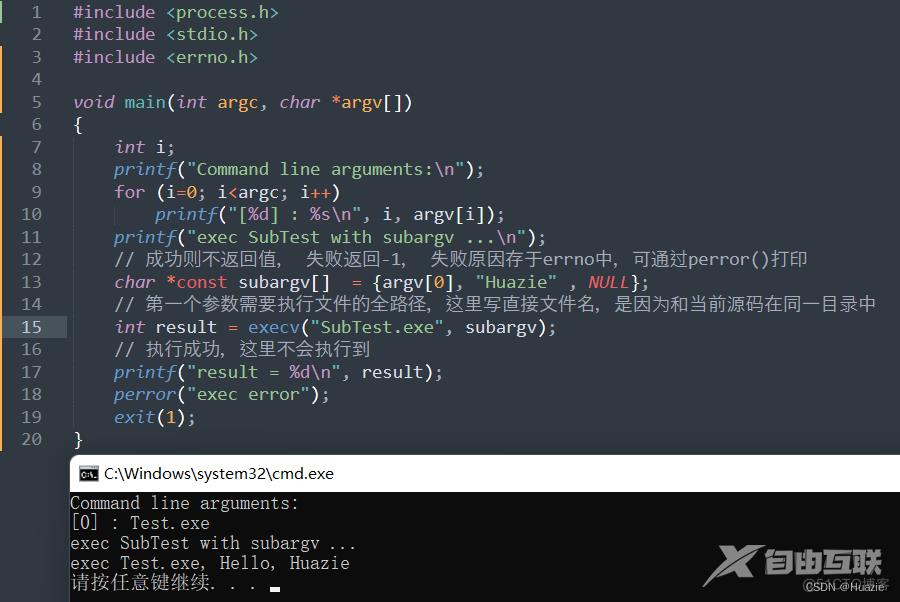
9. execve
9.1 函数说明
int execve(const char *pathname, char *const argv[], char *const envp[]);
载入并运行其它程序
注意:execve 函数用来运行參数 pathname 字符串所指向的程序,第二个参数 argv 为參数列表【该数组的最后一个元素必须是空指针 NULL】,最后一个参数为 环境变量。
9.2 演示示例
9.2.1 SubEnvTest.c
参考 5.2.1 的 SubEnvTest.c
9.2.2 Test.c
#include <process.h>
#include <stdio.h>
#include <errno.h>
void main(int argc, char *argv[])
{
int i;
printf("Command line arguments:\n");
for (i=0; i<argc; i++)
printf("[%d] : %s\n", i, argv[i]);
printf("exec SubEnvTest with subargv ...\n");
char *const subargv[] = {argv[0], "Huazie" , NULL}; // 参数列表
char *const envp[] = {"AUTHOR=Huazie", "DATE=2023-03-28", NULL}; // 环境变量
// 成功则不返回值, 失败返回-1, 失败原因存于errno中,可通过perror()打印
// 第一个参数需要执行文件的全路径,这里写直接文件名,是因为和当前源码在同一目录中
int result = execve("SubEnvTest.exe", subargv, envp);
// 执行成功,这里不会执行到
printf("result = %d\n", result);
perror("exec error");
exit(1);
}
9.3 运行结果
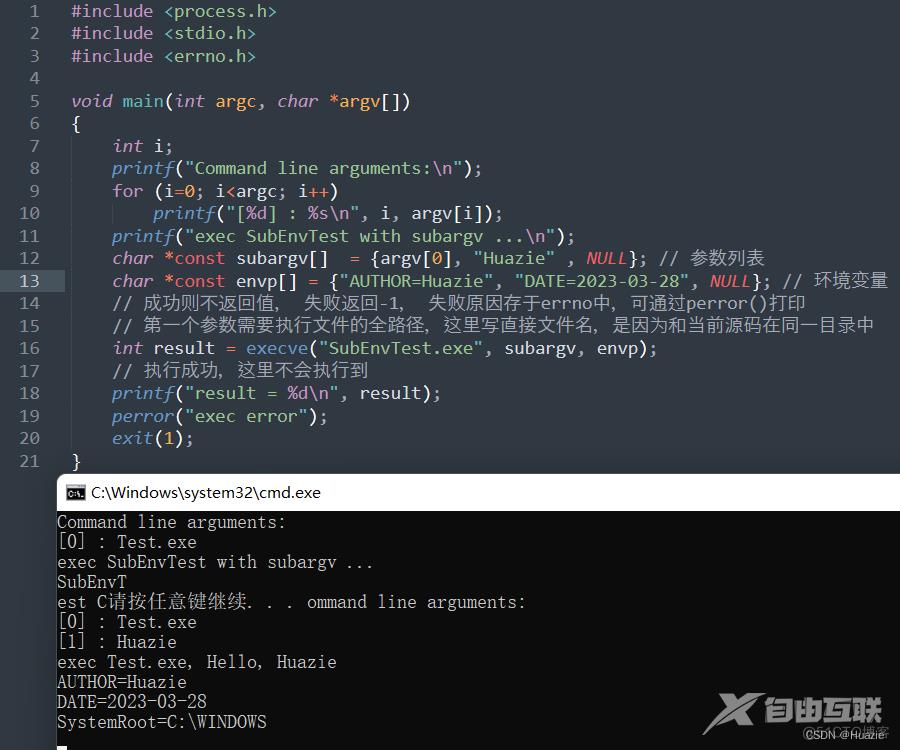
10. execvp
10.1 函数说明
int execvp(const char *pathname, char *const argv[]);
载入并运行其它程序
注意:execvp 函会从 PATH 环境变量所指的目录中查找符合参数 pathname 的文件名,找到后便执行该文件,第二个参数 argv 为參数列表【该数组的最后一个元素必须是空指针 NULL】。
10.2 演示示例
#include <process.h>
#include <stdio.h>
#include <errno.h>
void main(int argc, char *argv[])
{
int i;
printf("Command line arguments:\n");
for (i=0; i<argc; i++)
printf("[%d] : %s\n", i, argv[i]);
printf("exec java with subargv ...\n");
char *const subargv[] = {"java", "-version" , NULL}; // 参数列表
// 成功则不返回值, 失败返回-1, 失败原因存于errno中,可通过perror()打印
int result = execvp("java.exe", subargv);
// 执行成功,这里不会执行到
printf("result = %d\n", result);
perror("exec error");
exit(1);
}
10.3 运行结果

11. execvpe
11.1 函数说明
int execvpe(const char *pathname, char *const argv[], char *const envp[]);
载入并运行其它程序
注意:execvpe 函会从 PATH 环境变量所指的目录中查找符合参数 pathname 的文件名,找到后便执行该文件,第二个参数 argv 为參数列表【该数组的最后一个元素必须是空指针 NULL】,最后一个参数为 环境变量。
11.2 演示示例
11.2.1 SubEnvTest.c
参考 5.2.1 的 SubEnvTest.c
11.2.2 Test.c
#include <process.h>
#include <stdio.h>
#include <errno.h>
void main(int argc, char *argv[])
{
int i;
printf("Command line arguments:\n");
for (i=0; i<argc; i++)
printf("[%d] : %s\n", i, argv[i]);
printf("exec SubEnvTest with subargv ...\n");
char *const subargv[] = {argv[0], "Huazie" , NULL}; // 参数列表
char *const envp[] = {"AUTHOR=Huazie", "DATE=2023-03-28", NULL}; // 环境变量
// 成功则不返回值, 失败返回-1, 失败原因存于errno中,可通过perror()打印
int result = execvpe("SubEnvTest.exe", subargv, envp);
// 执行成功,这里不会执行到
printf("result = %d\n", result);
perror("exec error");
exit(1);
}
11.3 运行结果
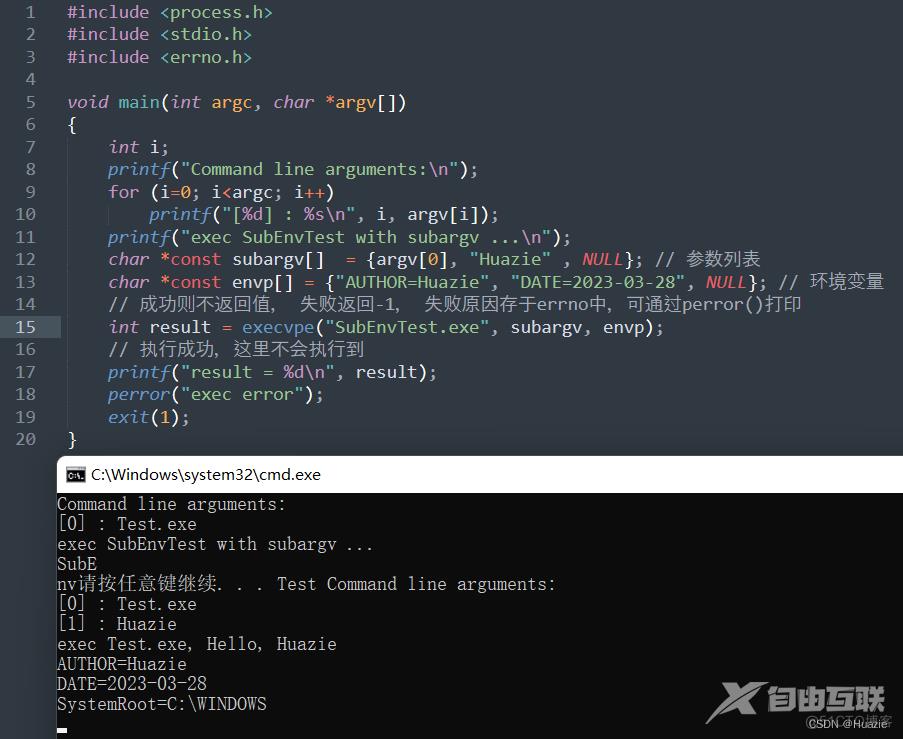
12. exit
12.1 函数说明
void exit(int status);
终止程序
注意: exit 函数通常是用来终结程序用的,使用后程序自动结束,跳回操作系统。
exit(0)表示程序正常退出【相当于主函数return 0;】,exit⑴表示程序异常退出【相当于主函数return 1;】。
12.2 演示示例
#include <stdlib.h>
#include <stdio.h>
int main(void)
{
int status;
printf("Enter either 1 or 2\n");
status = getchar();
/* Sets DOS errorlevel */
exit(status - '0');
/* Note: this line is never reached */
printf("this line is never reached!");
return 0;
}
12.3 运行结果
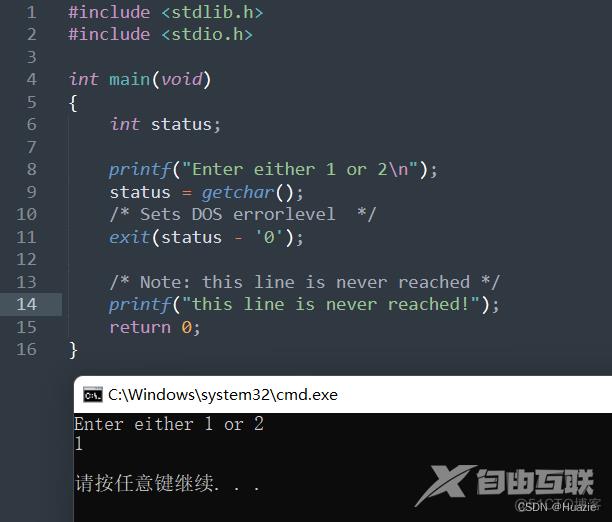
13. exp,expf,expl
13.1 函数说明
double exp(double x);
计算 x 的基数e指数(double)
float expf(float x);
计算 x 的基数e指数(float)
long double expl(long double x);
计算 x 的基数e指数(long double)
13.2 演示示例
#include <stdio.h>
#include <math.h>
int main(void)
{
double result, x = 4.0;
result = exp(x);
float resultf, xf = 4.0;
resultf = expf(xf);
long double resultL, xL = 4.0;
resultL = expl(xL);
printf("\n'e' raised to the power of %lf (e ^ %lf) = %.20lf\n", x, x, result);
printf("\n'e' raised to the power of %f (e ^ %f) = %.20f\n", xf, xf, resultf);
printf("\n'e' raised to the power of %Lf (e ^ %Lf) = %.20Lf\n", xL, xL, resultL);
return 0;
}
13.3 运行结果

14. exp2,exp2f,exp2l
14.1 函数说明
double exp2(double x);
计算 x 的基数为2的指数(double)
float exp2f(float x);
计算 x 的基数为2的指数(float)
long double exp2l(long double x);
计算 x 的基数为2的指数(long double)
14.2 演示示例
#include <stdio.h>
#include <math.h>
int main(void)
{
double result, x = 4.5;
result = exp2(x);
float resultf, xf = 4.5;
resultf = exp2f(xf);
long double resultL, xL = 4.5;
resultL = exp2l(xL);
printf("\n'2' raised to the power of %lf (2 ^ %lf) = %.20lf\n", x, x, result);
printf("\n'2' raised to the power of %f (2 ^ %f) = %.20f\n", xf, xf, resultf);
printf("\n'2' raised to the power of %Lf (2 ^ %Lf) = %.20Lf\n", xL, xL, resultL);
return 0;
}
14.3 运行结果
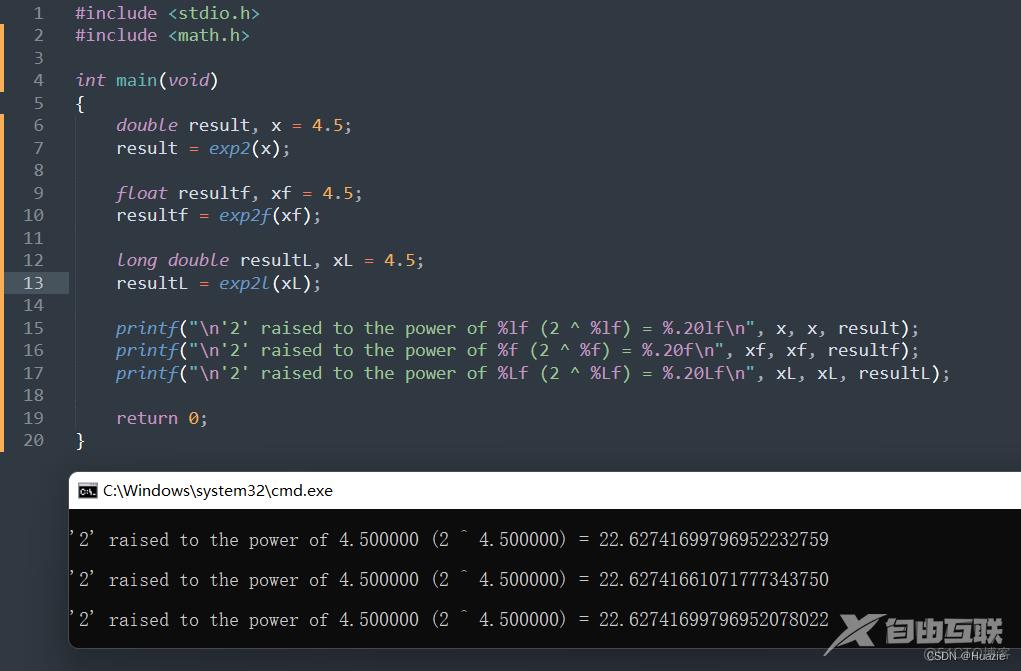
15. expm1,expm1f,expm1l
15.1 函数说明
double expm1 (double x);
计算 e 的 x 次方 减 1,即 (e^x) - 1 (double)
float expm1f (float x);
计算 e 的 x 次方 减 1,即 (e^x) - 1 (float)
long double expm1l (long double x);
计算 e 的 x 次方 减 1,即 (e^x) - 1 (long double)
15.2 演示示例
#include <stdio.h>
#include <math.h>
int main(void)
{
double result, result1, x = 4.0;
result = exp(x);
result1 = expm1(x);
float resultf, resultf1, xf = 4.0;
resultf = expf(xf);
resultf1 = expm1f(xf);
long double resultL, resultL1, xL = 4.0;
resultL = expl(xL);
resultL1 = expm1l(xL);
printf("\n'e' raised to the power of %lf (e ^ %lf) = %.20lf\n", x, x, result);
printf("\n'e' raised to the power of %lf minus one (e ^ %lf - 1) = %.20lf\n", x, x, result1);
printf("\n'e' raised to the power of %f (e ^ %f) = %.20f\n", xf, xf, resultf);
printf("\n'e' raised to the power of %f minus one (e ^ %f - 1) = %.20f\n", xf, xf, resultf1);
printf("\n'e' raised to the power of %Lf (e ^ %Lf) = %.20Lf\n", xL, xL, resultL);
printf("\n'e' raised to the power of %Lf minus one (e ^ %Lf - 1) = %.20Lf\n", xL, xL, resultL1);
return 0;
}
15.3 运行结果
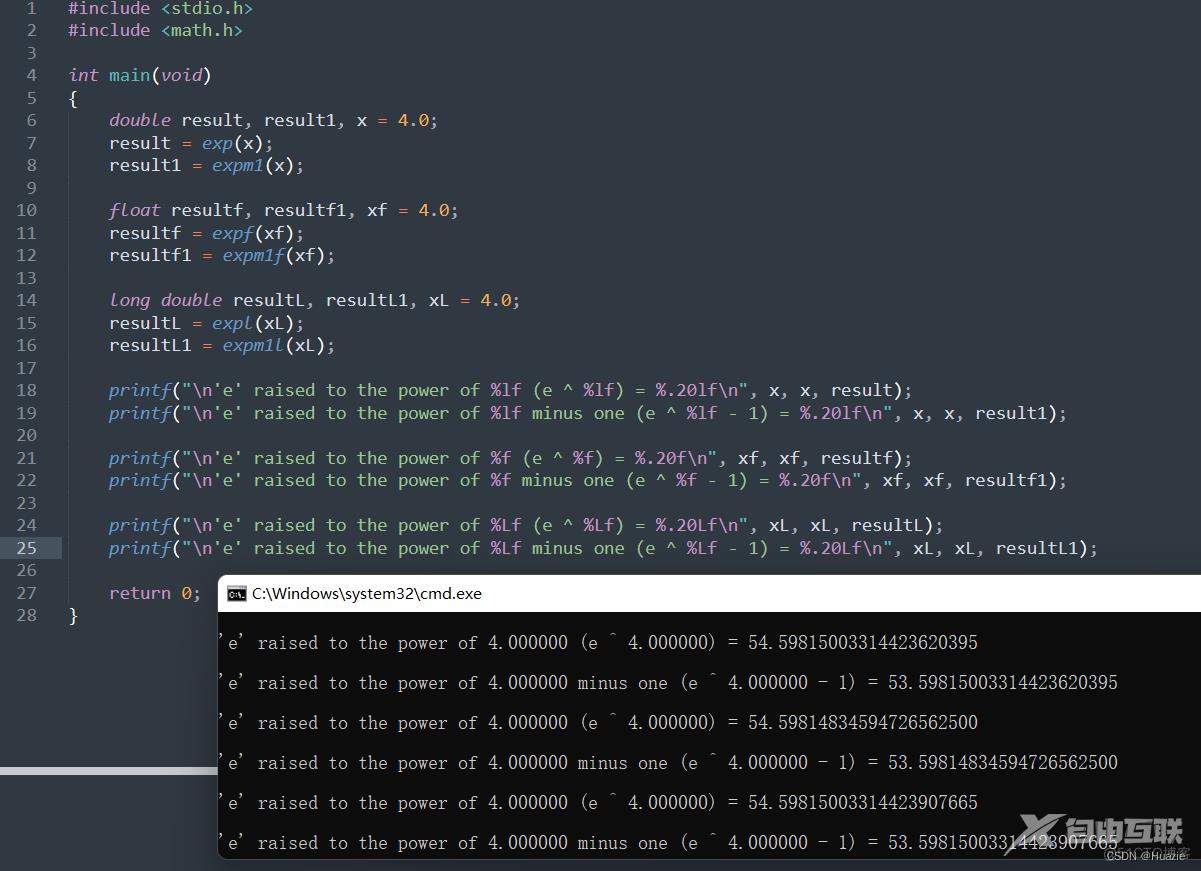
16. erf,erff,erfl
16.1 函数说明
double erf (double x);
计算 x 的 误差函数(double)
float erff (float x);
计算 x 的 误差函数(float)
long double erfl (long double x);
计算 x 的 误差函数(long double)
16.2 演示示例
#include <stdio.h>
#include <math.h>
int main(void)
{
double result, x = 2.0;
result = erf(x); // 高斯误差函数
float resultf, xf = 2.0;
resultf = erff(xf);
long double resultL, xL = 2.0;
resultL = erfl(xL);
printf("the error function of %lf = %.20lf\n", x, result);
printf("the error function of %f = %.20f\n", xf, resultf);
printf("the error function of %Lf = %.20Lf\n", xL, resultL);
return 0;
}
16.3 运行结果
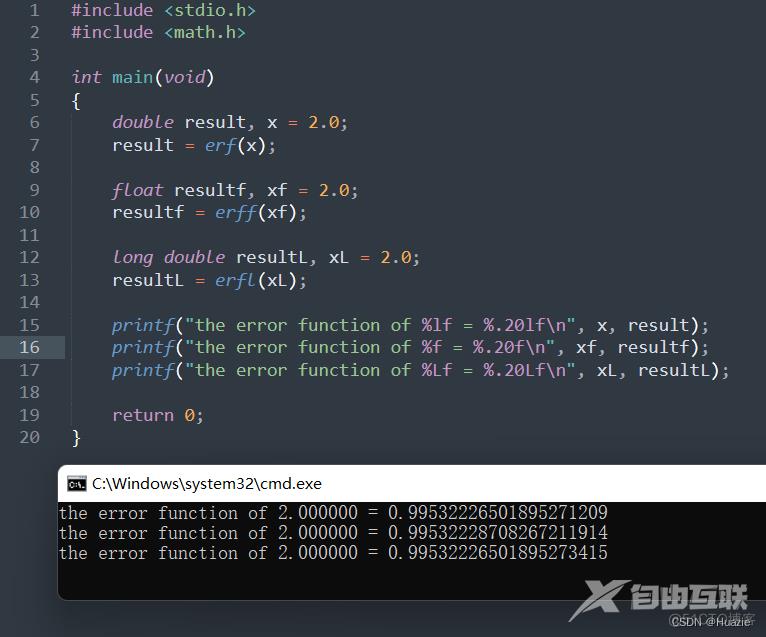
17. erfc,erfcf,erfcl
17.1 函数说明
double erfc (double x);
计算 x 的互补误差函数(double)
float erfcf (float x);
计算 x 的互补误差函数(float)
long double erfcl (long double x);
计算 x 的互补误差函数(long double)
17.2 演示示例
#include <stdio.h>
#include <math.h>
int main(void)
{
double result, x = 2.0;
result = erfc(x); // 互补误差函数
float resultf, xf = 2.0;
resultf = erfcf(xf);
long double resultL, xL = 2.0;
resultL = erfcl(xL);
printf("the complementary error function of %lf = %.20lf\n", x, result);
printf("the complementary error function of %f = %.20f\n", xf, resultf);
printf("the complementary error function of %Lf = %.20Lf\n", xL, resultL);
return 0;
}
17.3 运行结果

参考
- [API Reference Document]
- [ecvt 函数]
- [exec函数]
